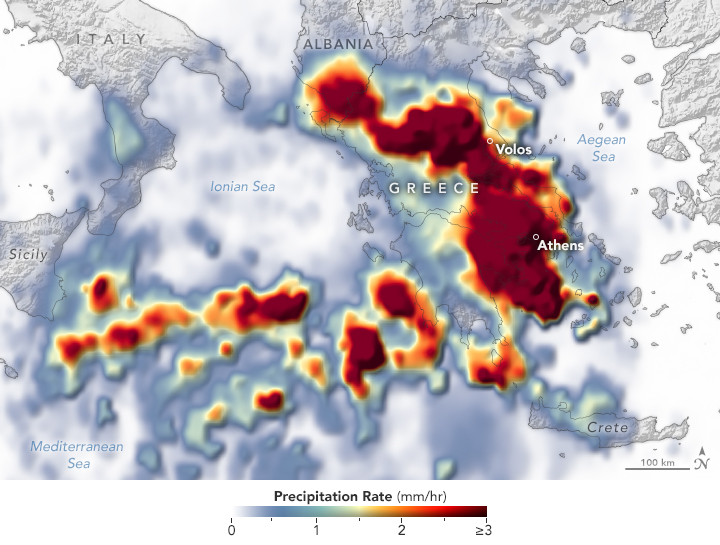A Deluge in Greece
Sep 8, 2023
Following weeks of heat waves and fires, torrential rains unleashed widespread flooding in central Greece in early September 2023. Over the course of the four-day storm that began on September 4, floodwater submerged homes, turned streets into raging rivers, and swept cars out to sea.
The heavy rainfall was fueled by a stalled low-pressure storm system that became cut-off from the jet stream, also known as a cut-off low. This storm was similar in nature to the cut-off low that caused downpours in Spain on September 3, and is part of an unusual omega weather system, in which a zone of high pressure is sandwiched between two areas of low pressure. This omega weather system was blamed for both an unseasonal heatwave in the UK and the catastrophic flooding in Spain, Greece, Bulgaria, and Turkey.
Central Greece was among the hardest hit by the storm in terms of rainfall, with record amounts falling on the Thessaly region on September 5. The highest levels of rainfall, 754 millimeters (30 inches), fell on Zagora, a village near Mount Pelion, just northeast of Volos. For comparison, the capital city of Athens receives an average of about 400 millimeters (16 inches) in a year. The Krafsidonas River, which originates in Mount Pelion, broke its banks in Volos and destroyed a bridge in its path.
The map above depicts a satellite-based estimate of rainfall rates (in millimeters per hour) over Greece for September 6, as heavy rain continued. The darkest reds reflect the highest rainfall rates, which again hit central Greece as well as areas to the south, including Athens. The data are remotely sensed estimates that come from the Integrated Multi-Satellite Retrievals for GPM (IMERG), a product of the Global Precipitation Measurement (GPM) satellite mission. Due to averaging of the satellite data, local rainfall rates may be significantly higher when measured from the ground.
Using satellite data from the European Space Agency’s Sentinel-1 satellite, Meteo reported that as of September 6, large parts of Thessaly had been flooded. On that day, 331 millimeters (13 inches) fell on the city of Karditsa, which is about 100 kilometers (60 miles) inland from Volos. Athens received 55 millimeters (2 inches) of rain, according to Meteo.
The same low-pressure system produced deadly flooding in eastern Bulgaria and western Turkey on September 5, but eased by the next day. In Greece, the storm gradually receded by the evening of September 7.
Some of Meteo’s meteorological stations stopped transmitting due to power outages, but over the four-day storm, they recorded the most cumulative rain over the Thessaly region. Zagora saw 910 millimeters (36 inches), and 659 millimeters (26 inches) fell on Karditsa.
NASA Earth Observatory image by Lauren Dauphin, using IMERG data from the Global Precipitation Mission (GPM) at NASA/GSFC. Story by Emily Cassidy.
